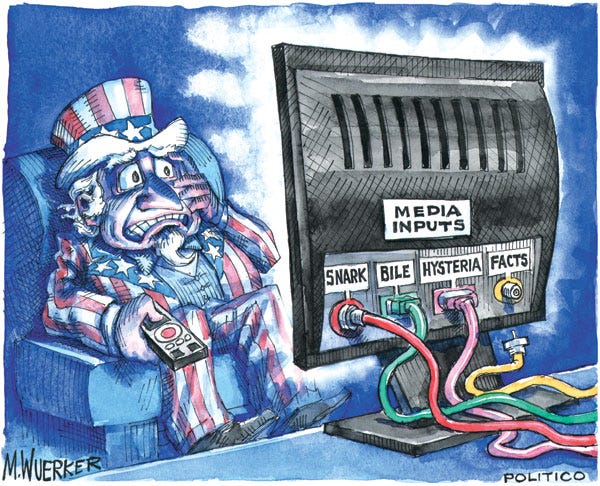Navigating the Media Maelstrom
How our hyper-connected age is destroying attention spans, eroding critical-thinking & tearing us apart...
| Oct 30 | Public post |
 |
The multi-tabbed, multi-screen, multi-channeled, multi-media prism through which we currently experience the world is already wreaking havoc with our ability to think clearly.
The constant competition between signals clawing for attention erodes our ‘working memory’ - the neural architecture associated with our capacity for controlled attention and complex reasoning.
Increasingly we interact with information through stimulus-driven attention; the unthinking animal response.
Any mashup of dubious stats, images, half-truths and hyperbole can be arranged in a way that can make the most preposterous conclusions appear plausible.
The ease of access to information through search engines has created the illusion that truth is at our fingertips, instead, it is the ability to justify any prejudice or bias in seconds, or find communities to do it on our behalf.
Manipulation, Tribalism & Estrangement From Reality
From artfully crafted selfies to outrage-inducing memes, we treat information pulled from the Media Maelstrom like so much ochre paste and seashells; simply baubles with which to decorate ourselves, there to signal social status and tribal allegiance.
Outrageous claims don’t need to stand up to much scrutiny because we’re often not even thinking about this media - and max-out on cognitive biases when we do.
Indeed, scrutiny is increasingly hard work.
Even when we can force ourselves to wield deep attention long enough to do some sleuthing, the vast amounts of information available to us means that any topic can be explored in fractal levels of detail, with certainty itself remaining frustratingly elusive.
While “truth” might indeed lurk out there in the murk of the deep web, journeying out there to find it and bringing it back to the ordinary world is far too onerous for many to contemplate.
Instead, things are “true” when they provide social validation within a like-minded peer group — the only metric of consequence — and not any proximity to empirical reality.
It will come as little surprise to the reader that these frailties are routinely exploited.
The Darwinian struggle for attention - between advertisers, marketers, bloggers, charlatans, narcissists, political fanatics, religious zealots, propagandists and general attention seekers - results in a race-to-the-bottom tactic to trigger emotions and get a hasty share or retweet.
 |
Our Descent into the Maelstrom
Writing during the twilight age of literature, maverick media theorist Marshall McLuhan devoted his life to the understanding of the global mass media and its effect on human behavior.
He argued that by changing our sense ratios, different communication technologies altered the focus of our mental attention and affected us both on an individual and societal level.
The media theorist Kevin Kelly similarly writes of how the medium of the book neurologically changed the brain, making it ‘focused, immersed,’ training our minds to follow a single topic in incredible depth.
He calls it “literature space:”
“One can spend hours reading on the web and never encounter this literature space. One gets fragments, threads, glimpses.That is the web’s great attraction: miscellaneous pieces loosely joined.But without some kind of containment, these loosely joined pieces spin away, nudging a reader’s attention onwards, wandering from the central narrative or argument.”
In 2007, English professor Katherine Hayles wrote of modern media causing a shift from ‘deep attention’ that involves concentrating one’s mental focus on a single object or information stream, to what she calls ‘hyper attention,’ which is: ‘Characterized by switching focus rapidly among different tasks, preferring multiple information streams, seeking a high level of stimulation, and having a low tolerance for boredom.’
She did not see this so much as a new evolutionary adaptation to cope with the challenges of navigating the Media Maelstrom, so much as a reversion to a much older way of processing sensory information, drawn from our deep past in the Paleolithic jungle.
She wrote this the same year the iPhone entered the market, massively escalating the war for our attention, creating a new, user-friendly means for psychic contagion to spread at the speed of light, right into the palm of our hands.
McLuhan also saw that the mass media was making the world smaller, coining the phrase the “global village,” prophesying electronic media (as he called it) would have a “retribalizing” effect on us by shifting us back to oral rather than literate cultural patterns.
While the idea of the global village has practically entered the common tongue, one lesser known metaphor ran through all of his work but perhaps summed up his thinking more totally; the Maelstrom.
The term was drawn from Edgar Allan Poe’s short story, A Descent into the Maelstrom.
McLuhan saw the mass media as a titanic vortex pulling society towards new forms of behaviors — new ways of being — that threatened to completely overwhelm or even destroy it.
In the electric age, the fluid nature of information and the sheer amount of it thwarted our attempts at top-down classification methods so characteristic of literate culture.
His hope, like the sailor protagonist of the poem, if we now study the perturbations and ‘configurations’ of the mass media, we can make sense of it and devise a way to escape its centripetal pull.
As McLuhan put it:
“The huge vortices of energy created by our media present us with similar possibilities of evasion or consequences of destruction.
By studying the patterns of the effects of this huge vortex of energy in which we are involved, it may be possible to program a strategy of evasion and survival.”
At the same time McLuhan was captivating television audiences with his often cryptic prophesies and ideas, the political scientist Herbert Simon was discussing the evolving landscape of communication technology from a less poetic, but perhaps more practical perspective.
When he coined the phrase “attention economy” in the early 70s, about 18 computers were attached to the internet. Even though the internet was still in its infancy, he could see how the growth of global mass media and cheap publishing were putting an increasing strain on our ability to collect and process information, writing that:
“A wealth of information creates a poverty of attention and a need to allocate that attention efficiently among the overabundance of information sources that might consume it.”
He viewed this first and foremost as an organizational challenge; that “scarcity of attention in an information-rich world will be measured by the time, in minutes or hours, say, of a human executive” and as such, the information presented to them then needed to be accurate, useful and worthy of attention to begin with.
If it was deficient in any part and did not correspond to reality, any decisions based on it could be botched at best and catastrophic at worst.
The larger and more hierarchical the organization the greater the challenge, as each layer acts as an information filter that selectively processed data to channel to the top of the “pyramid.”
This being the height of the Cold War, the hierarchical system that most concerned Simon was the American Government, writing that “a frightening array of matter converges on that single, serial information processing system, the President of the United States.”
Today, Big Data problems are still primarily framed as commercial and organizational challenges; of how wisdom can be sourced from exponential oceans of data measured in exabytes, zettabytes or other numbers alien to human scale.
As more of us migrate online, and the more physical environment is colonized with information harvesting devices to catalogue every waking and sleeping moment, this is only going to get worse in the coming decades and centuries.
Today the sheer speed at which we are exposed to information undermines any systematic and rational analysis almost by its very nature, either as organizations or as an individual.
What was a whirlpool to McLuhan in the middle of the 20th century is today more akin to the Eye of Jupiter, a monster that, as it encroaches closer to our immediate realities, threatens to tear them apart.
In the words of the biologist E.O Wilson:
“We are drowning in information, while starving for wisdom.The world henceforth will be run by synthesizers, people able to put together the right information at the right time, think critically about it, and make important choices wisely.”
~ While researching my new book, I came across several articles from Jamie Stantonian, a “UX Architect who studies the history of ideas.” I was impressed by his concise vital insights into our modern media maelstrom and decided to create the article above as a remix of his brilliant work. You can read Jamie’s essays here.
This email list is now my primary publishing platform.
If you subscribe at the annual rate, I will send you a 1st Run Limited Edition version of my new book as soon as it is released. There will only be 500 copies printed of the collector’s version.
If you subscribe on a monthly basis, I will send you a 2nd run edition. There will be approximately 10,000 copies printed of that version.
This post is also featured on our new social network: Changemaker.Media
Read it here: Navigating the Media Maelstrom
I am now posting to Changemaker.Media on a daily basis. Join me!
You’re on the free list for Quantum Politics. For the full experience, become a paying subscriber.